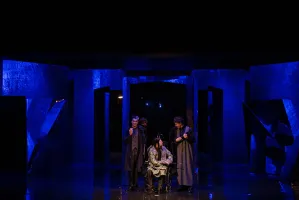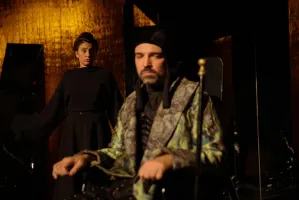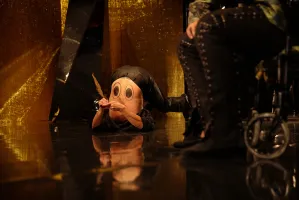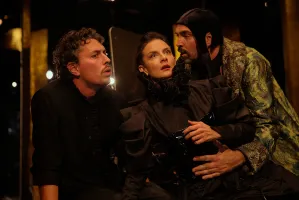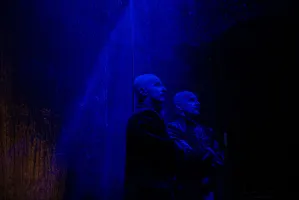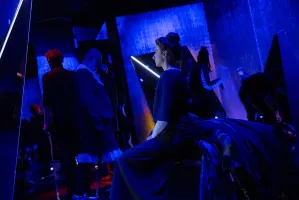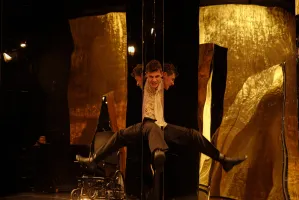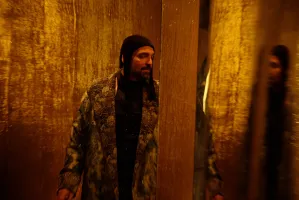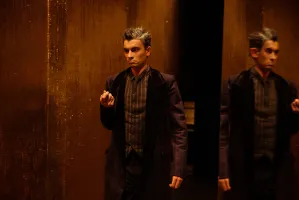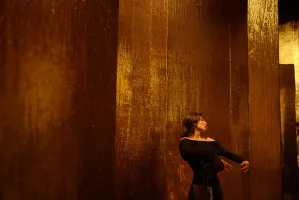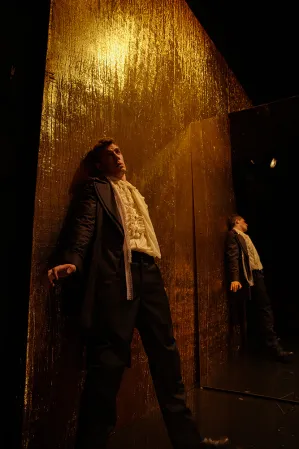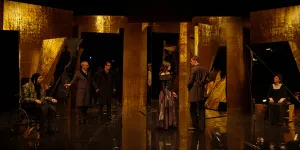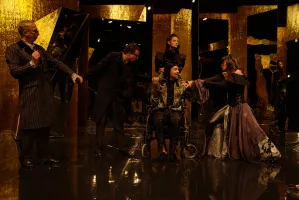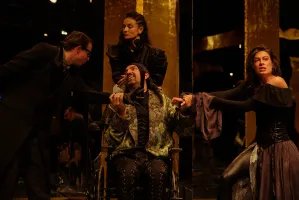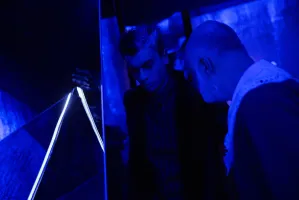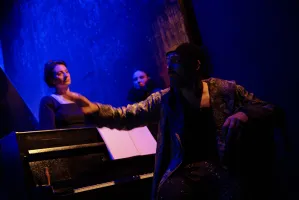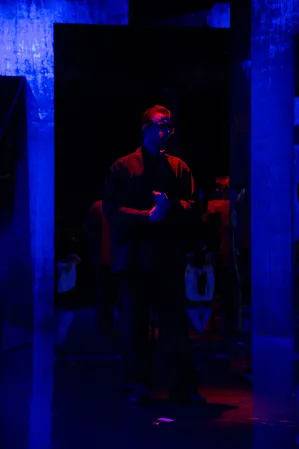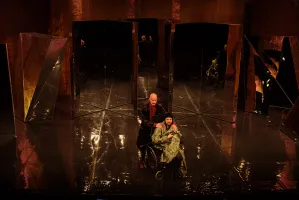The Imaginary Invalid
comedy by J.B.P. Molière
Repertoire
„Raša Plaović” stage, 28 January 2026, 20:30
„Raša Plaović” stage, 31 January 2026, 20:30

A Word from the Director
In our version of “The Imaginary Invalid”, we present to the audience one possible vision of Molière – the actor, the leader of his theatrical troupe consisting of exceptional actors, and Molière the man.
We have preserved in our production the elements found in Molière’s original (this is a specific genre first introduced by Molière himself – the comédie-ballet), which are most often left out in interpretations of “The Imaginary Invalid”: the eclogue (the opening scene), the pastoral play as an apologia to Louis XIV (Molière’s patron at court and his child’s godfather), and the interludes (pieces with music and dance that serve as a break from the main plot, a warm-up for the next act).
To be honest, in our production, during these short breaks from the plot, something else happens – something significant for the group of actors we are watching (who are performing the play in the presence of King Louis, which is a crucial circumstance), something the audience would not see in a regular performance: we find ourselves at the fourth performance of “The Imaginary Invalid”, on 17 February 1673. We go behind the curtain and see the actors preparing for the next act, we see that Monsieur Molière is ill, that he is unwell, and we realise that, from an outside perspective, performing this comedy has now become a matter of life and death for him. We wanted to embark on a riskier, and more challenging theatrical endeavour. The powerful current of Molière’s fate drew us onto such a path, into such a performance. We used the force offered by the incredible symbolism of his death, which literally began on stage, during his fourth performance as Argan, the imaginary invalid. This circumstance firmly but gently imbues the course of our play and makes it, alongside its playful comic energy, delicate and almost tragic.
Nikola Zavišić
Dramaturgical Notes
Avertissement au lecteur or Three-in-One
The originality of the comédie-ballet came from the fusion of three arts and their three distinct languages: the spoken word in dialogue-based comedy, music, and dance, which are present in what Molière and his contemporaries referred to as ornamental elements or so-called embellishments interwoven into the comedy or appearing during interludes/act transitions. A comédie-ballet should thus be understood as a collaborative undertaking: led, of course, by Molière who sought to maintain control over all segments to ensure the unity of the spectacle, something he largely succeeded in, but it also involved close collaboration with composers, choreographers, dramaturgs, poets...
Molière most likely learned most about the performing arts from the Jesuits at the Collège de Clermont, and he was fully familiar with the aesthetic dictum of his time when it came to dance. According to the principle of imitatio, everything performed had to be imitated: the sets, costumes, stage props, but above all, the movements and physical expression of the performers. They were requested to be capable of imitating everything - from emotions and passions to different social types, mythological figures, and even natural phenomena.
Theorists of the time argued that dance expresses the very nature and habits of the soul; it expresses, portrays, and re-creates them through dramatic action. Molière had a clear vision of the beauty and charm of dance, of its expressive and emotional power, of the sense of harmony it evoked and its ability to inspire both the individual and the broader audience, especially when closely tied to music. Before his choreographer and at the same time before his composer, he would place a group of performers skilled in bringing the inserted intermèdes to life and in enriching the plot with musical ornamentation: allegorical figures, gods, pastoral characters, commedia dell’arte characters, and those borrowed from everyday life, whether common or exotic. Dressed in costumes and incorporating the full range of their physical abilities into dance, dancers performed carefully choreographed performances before the King and courtiers to a diverse dance music, although the movements, steps, figures, and other details and overall style are today almost impossible to reconstruct with authenticity.
The phenomenon of imitation inevitably evokes the accusation that Molière plagiarized Scaramouche – an accusation that echoed widely and culminated in the famous War of Comedy, the so-called guerre comique, after the 1662 performance of The School for Wives and the publication of The School for Wives Criticized. Many claimed that Molière shamelessly copied Scaramouche’s costume, appearance, facial features, acting style, and even comedic structure. De Chalussay summed up these claims in a widely cited passage from his Elomire Hypocondre, in which he describes the actor Elomire (i.e.Molière) holding a mirror in his hand and mimicking every “contortion, posture, grimace of the great Scaramouche.”
Theatrologists have mostly agreed that there is a fundamental truth to this – a calculated attack aimed at discrediting an opponent. Bernadette Rey-Flaud, for instance, in a study on Molière and the tradition of farce acting, views Molière’s first documented contact with the Italians in Paris as the final stage of his theatrical apprenticeship. Far from serving their original defamatory purpose, these attacks reflect the dominance of physical characterization and the organic inner energy in Molière’s performance style that had been developing from the buffo or comic register to a more naturalistic acting style. Jocelyn Powell interpreted this description as tangible evidence of the remarkable emotional transformations that Molière could render through facial expression and physical movement.
In a more detailed analysis of the composition of Molière’s troupe, Roger Herzel argued that the true cause of the transition from a jeu bouffon to a jeu naturel lay in the troupe’s internal role casting within the interludes. Molière’s revolutionary acting style should be understood in the context of the juxtaposition between the grotesque style of Gros-René and the heroic style of La Grange. Herzel’s observations were repeated by Samuel Taylor in the same collection of essays, who emphasizes the role of gesture in the mutual enrichment of the Italian style with Molière’s innovations on the neoclassical stage. Gesture was the basic element of both tragic and comic registers of acting styles; however, the difference between Italian and French tragedians of Hôtel de Bourgogne lay in the following: the former paid particular attention to syntax, rhythm, design, and the arrangement of their simple vocabulary within dramatic dialogue. The stillness or physical immobility and the clear reduction of bodily gestures for rhetorical effect in tragedy, the brio of Italian pantomime, and the dominance of the word over the body all emerged at a moment that would have a lasting impact on acting styles in Western Europe from that point onward.
The actor’s body is liberated and placed at the very centre of theatrical action. Richard Andrews cites an engraving as evidence of Italian influence on Molière - the actor/author holds a mirror rich in metaphor which we can interpret in light of the reflective satire it alludes to. However, we can reverse this image and imagine Scaramouche holding the mirror up to Molière. In the comedy Le Triomphe de la médecine, performed in 1674, Scaramouche plays a hypochondriac who has been deceived by the medical profession and persuaded to join their ranks - a plot clearly inspired by Molière’s final performance of The Imaginary Invalid.
Molière was likely related to the old family of musicians named Mazuel, and by taste, upbringing, and intuitively he was deeply connected to music itself. Like any performing art, music had a special status at court and in society and like dance, it imitated nature, especially passions and emotional states, for which the imitative language of music found fitting expression. Molière integrated the irresistible charm of music, capable of moving everyone, into the creative synthesis of its hybrid genre: the comédie-ballet.
He collaborated with numerous composers. He and Lully – the other Baptiste – who was gaining fame at the time thanks to Louis XIV, who was his great admirer, quickly developed a strong partnership, in aesthetic, creative and personal sense. Lully was willing to dedicate his talent and energy, his dramatic and stage instinct, and his vast experience composing court ballets to the service of the comédie-ballet. Their fruitful collaboration of the “two Baptistes”, as a nod to their shared middle name, lasted from 1664 until 1672, when Lully turned to opera, or lyrical theatre, aiming to be the first to offer French society a fully realised musical theatre production. But Molière and the comédie-ballet had beaten him to it, so their further collaboration was unthinkable.
After this creative divergence came a separation – Opera yielded primacy to the composer, while in comédie-ballets, overall control and prominence belonged to the playwright i.e., to the spoken word on stage, so Molière thus turned to a young genius, the composer Marc-Antoine Charpentier, known for his talent but envious Lully deliberately sidelined him. Although their collaboration was short-lived, the result was remarkable – The Imaginary Invalid reached artistic heights equal to those achieved in Molière’s earlier partnership with Lully in The Middle Class Gentleman (Le Bourgeois Gentilhomme).
Musicologists have closely analysed the musical forms of both composers. The atmosphere was carnivalesque and playful, but unlike orchestral pieces (overtures and ritornellos), comédie-ballets placed particular emphasis on vocal music. Characters performing musical segments or interludes, sometimes structured as miniature dramatic episodes (given that both Lully and Charpentier composed really powerful theatrical music), sang solo, in duets or trios (offering a variety of vocal registers and emotional richness), or combined into a mixed or double choir. Molière had a dramaturgical mind and wrote texts with music in mind, and composers adjusted their music to enhance the expressive and emotional impact of the spoken word.
This is why it is essential to return to the original scores and attempt to envision the performers in action if we truly appreciate the richness, diversity, and ornamental beauty of the music and dance. After an overture in the French style, whose purpose was to transport the audience into an imaginary world, musical and choreographic embellishments would stir specific emotions and moods in the audience during the performance. Two principal emotional tones dominated: the first rooted in the blend of emotions typical of the pastoral genre, featuring familiar characters – aloof shepherdesses and passionate shepherds burning with desire and sorrow until they finally unite in harmony – though Molière and Lully often openly mocked pastoral conventions; the second was founded in the general comedic tone, inspired by diverse musical and verbal languages working in tandem and joy shattered the monotony of everyday life, ridiculing pedants (such as lawyers or doctors), and transforming grand burlesque ceremonies seen at their peak in The Imaginary Invalid and Le Bourgeois Gentilhomme – into true masterpieces of musical comedy.
Although the union of different arts is the original contribution of the comédie-ballet, it also brought certain aesthetic and genre challenges that Molière had already noticed in Le Fâcheux, in his attempt to integrate grafted ballet numbers into the dramatic action “so that comedy and ballet become a single work” (“Avertissement au lecteur”). Musical embellishments inspire, provoke laughter, seduce, charm – in a word, they move us through the combined grace of poetry, melody, and dance. But how can such musical delights be successfully integrated into comedy? How can three such distinct art forms be combined into a coherent whole? How can their fusion be aesthetically acceptable?
The spirit of carnival with its satirical re-examination of order and hierarchy, its play of masks and disguise that inspire raucous farce and enables Molière to showcase the shattering of bourgeois illusions, coincides with the simultaneous need for a cheerful tone. Ambivalent laughter, which both punishes and delights, strives to rescue us from the cold and cruel world exposed through the relentless analysis of character and human relationships, while the ornaments of the comédie-ballet wittily enhance the sparkling dialogues to the audience’s delight. Molière would likely agree with the view that theatrical happiness has its limits; but his affirmation of joy awakens a belief, or at least a longing, that the world could be a better place to live, and humanity a happy one.
Attempting to somewhat rehabilitate the genre of comédie-ballets, written both for the Parisian audience and the court, where they were first staged, it was essential that we, as a team, listened carefully and recognised their beauty and charm of their musical ornaments, and the thematic originality and multivalence achieved through the fusion of the three arts, without seeking to separate them from the rest of Molière’s body of work. If the comédies-ballets emphasise the extent to which Molière was a Baroque playwright, they are also closely linked with his other comedies that contain no fantastical elements. The Imaginary Invalid, although paradoxical, is yet most striking example that refutes this thesis.
As unbelievable as it may sound, this genre, which Molière created with the help of his close collaborators – composers and choreographers – unfortunately died with him. To be honest, we come across comedies brought to life with music and dance whose authors are his contemporaries and successors. But Molière’s secret was lost: other playwrights failed to discover the internal necessity born from the union of three arts, and the unity through which Molière embraced contradictions in order to create new meaning. This is all the more reason for his comédies-ballets to be staged and performed more frequently, in their full integrity and complete duration.
Molière’s The Imaginary Invalid is regarded as the apotheosis of the genre, as it rests on a unique pleasure that music, dance, and movement offer from within the comedy itself. At the heart of this spectacle, in the fullest sense of the word, enriched with music and choreography, lies the process of sublimating diverse elements into a comedic climax. In the Ballet of the Nations, which runs for over forty minutes, not counting the preceding scenes, we can sense the climax of an aspiration to merge musical elements in a deliberate excess. Molière undoubtedly sought to establish a more harmonious relationship with his new composer while working on The Imaginary Invalid, only to ultimately return to the well-tested model based on separate interludes; more than half of Charpentier’s score is dedicated to the prologue – a long pastoral eclogue with music and dance in a play that Molière never got to perform before the king, just before his death. In contrast, our reconstruction, directed by Nikola Zavišić, though close to historical sources and the original, is metatheatrical and interdisciplinary keeping with the spirit of our time – and, as the title suggests, imaginary.
Today, it is virtually impossible to imagine a serious study of the great playwright without firmly positioning him within the social, cultural, and even political context that necessarily informs us of every aspect of artistic activity. That is why we resolved, from the very beginning of our process, not to mythologise or romanticise it. In order to demonstrate the harshness of the performance conditions of the time, we found a link with contemporary production systems devoid of empathy and driven by an unforgiving dictate: Show must go on! The cost of staging The Imaginary Invalid at that time was enormously high and amounted to 2,400 livres, which made it impossible for the troupe to fully capitalise on their investment. There was a blind hope that the troupe might pay off their creditors by continuing to perform this expensive, new, and entertaining production regularly and do so without pause. This is best illustrated by a decision that has rightly drawn criticism from modern scholars and theatre critics alike: The Imaginary Invalid was returned to the repertoire only one week after Molière’s death.
Periša Perišić
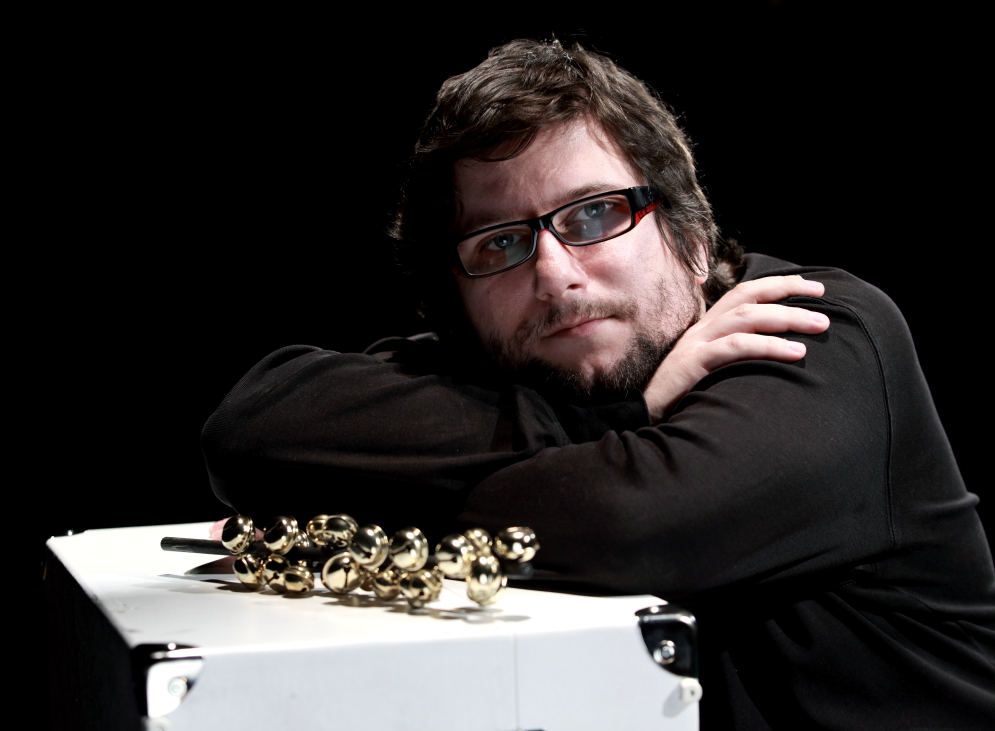 Nikola Zavišić
Nikola Zavišić
Theatre director, dramaturge, writer, and lighting designer. Born in 1975.
He earned his master’s degree from the Academy of Performing Arts in Prague (DAMU), Department of Alternative and Puppet Theatre Directing, in 2003. In addition to his work within institutions, he explores experimental uses of light with the art group Radio.Nica, which he founded. He has directed in numerous theatres across Serbia and abroad (Croatia, Slovenia, Czech Republic, the Netherlands, Russia), and has received multiple awards for his work at both national and
Premiere performance
Premiere: 5 December 2024
"Raša Plaović" Stage
J. B. P. Molière
The Imaginary Invalid
Translation: Bogdan Popović
Directed by: Nikola Zavišić
Dramaturgy: Periša Perišić
Speech coach: Dr Ljiljana Mrkić Popović
Set designer: Jelena Radović
Costume designer: Suna Kažić
Composer: Jovan Stamatović-Karić
Choreographers: Tamara Pjević, Jakša Filipovac
Sound design and soundscapes: Vladimir Petričević
Producers: Nemanja Konstantinović, Vuk Miletić
Stage manager: Sanja Ugrinić Mimica
Prompter: Marija Nedeljkov
Assistant costume designer: Ana Petrović
Production Interns: Milica Rakočević, Nina Nikolić
Premiere Cast:
Argan Ivan Bosiljčić
Béline Sonja Kolačarić
Toinette Anastasija Mandić
Monsieur Purgon Danilo Lončarević
Monsieur Diafoirus Zoran Ćosić
Thomas Diafoirus Sava Milutinović
Monsieur Bonnefoy Nemanja Stamatović
Monsieur Fleurant Nemanja Stamatović
Angélique Iva Milanović
Cléante Vučić Perović
Béralde Nikola Vujović
Louison Nemanja Konstantinović
Jean Jacques Jovan Stamatović-Karić
Peasant Women Elena Jovanović, Ina Ilievska, Emilija Milošević
Lighting Designer: Milan Kolarević
Makeup Artist: Marko Dukić
Sound Engineer: Dejan Dražić
Stage Manager: Zoran Mirić
Costumes and sets produced in the workshops of the National Theatre in Belgrade
Performance duration: 1 hour and 45 minutes

